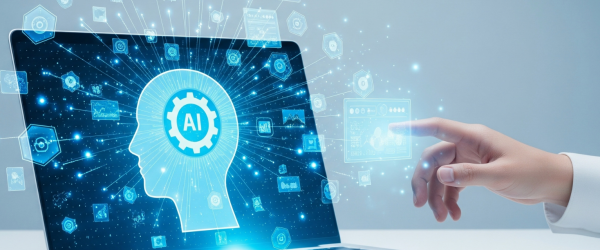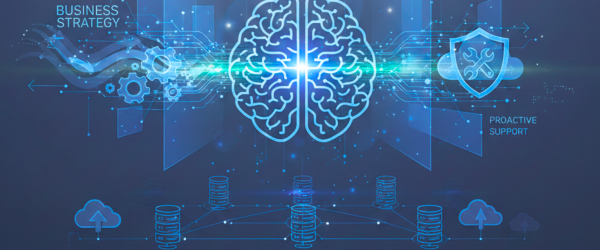Introduction
For decades, IT operations and service management have been governed by rigid, rule-based systems. These systems, while reliable, struggled with the complexity, ambiguity, and sheer volume of unstructured data inherent in modern enterprise environments—think support tickets, complex troubleshooting logs, and developer documentation.
The arrival of Large Language Models (LLMs) and Generative AI marks a decisive pivot. These models are not just conversational tools; they are the new intelligence layer capable of understanding, summarizing, and generating human-like text and code. This capability is fundamentally redefining IT Services and Operations (ITSM/ITOps) by automating cognitive tasks, enhancing speed, and unlocking unparalleled efficiency.
LLMs in IT: From Simple Chatbots to Cognitive Automation
The global market for Generative AI in the enterprise is experiencing massive growth, confirming its rapid adoption. According to a report by McKinsey, Generative AI is expected to add $2.6 trillion to $4.4 trillion annually across various sectors, with IT and software engineering being prime areas for value capture (McKinsey, 2023).
The impact of LLMs stems from their ability to handle unstructured data—the lingua franca of IT problems.
1. Revolutionizing the Service Desk (ITSM)
The service desk, often the first point of contact for IT issues, is undergoing a complete transformation. Historically, chatbots only handled simple, pre-scripted queries. LLMs, however, can truly understand natural language, intent, and sentiment.
- Intelligent Triage and Routing: LLMs can analyze the full text of a support ticket (including error logs and history) to determine the urgency instantly, classify the issue, and route it to the correct specialized engineer without human intervention.
- Automated Knowledge Base Creation: LLMs can ingest thousands of pages of existing technical documentation and institutional knowledge, automatically synthesizing answers for complex queries. This leads to a higher First Call Resolution (FCR) rate. Forrester projects that implementing Generative AI for customer and employee service could reduce IT support costs by 30% (Forrester, 2024).
2. Accelerating Software Development (DevOps)
LLMs are becoming indispensable co-pilots for developers, accelerating the entire software lifecycle.
- Code Generation and Debugging: Tools leveraging LLMs can suggest code snippets, complete functions, and even generate boilerplate code from natural language instructions. Furthermore, when presented with an error stack trace, LLMs can often pinpoint the bug’s location and suggest fixes faster than a human, drastically reducing debugging time.
- Documentation and Testing: The models can automatically generate comprehensive documentation for existing codebases and create relevant unit tests, addressing two traditionally time-consuming and often neglected aspects of development. An MIT study highlighted that developers using AI coding assistants completed tasks 55% faster than those working alone (MIT, 2023).
LLMs for Proactive Operations (ITOps)
Beyond user-facing services, LLMs are fundamentally improving the management of complex, hybrid infrastructure.
Semantic Search and Log Analysis
IT operations generate massive volumes of logs and alerts. When an outage occurs, finding the root cause often means sifting through petabytes of machine data. LLMs introduce Semantic Search. Instead of relying on exact keyword matches, engineers can ask the LLM natural language questions like, “Show me all database connectivity errors related to the Chicago cluster that happened 15 minutes before the application latency spiked.” The LLM understands the context and fetches only the relevant logs.
| Traditional Ops | LLM-Powered Ops (AIOps) | Efficiency Gain |
| Manual Log Search | Semantic Querying (natural language) | Faster Root Cause Analysis (RCA) |
| Scripting Alerts | LLM-Generated Remediation Scripts | Automated Incident Response |
| Ticket Handling | Automated Triage & Answer Generation | 30%+ Cost Reduction (Forrester, 2024) |
AI-Driven Remediation
The ultimate promise is automation. LLMs can analyze a diagnosed issue and then generate the specific code or command needed to fix it. For example, if an LLM identifies a full disk partition, it can generate the appropriate Unix command or PowerShell script, submit it to a secure automation engine, and resolve the issue without a human touching the keyboard. This rapid, targeted automation leads to a significant decrease in Mean Time to Resolution (MTTR).
Ethical Considerations and the Path Forward
While the value proposition is clear, the adoption of LLMs in IT is not without its challenges. Data privacy and security, especially when feeding proprietary enterprise data into models, are paramount. Furthermore, the risk of hallucination (where the model generates false information) necessitates human oversight for all critical, customer-facing, or operational actions. The future of IT services is a human-in-the-loop model, where LLMs handle the cognitive lifting (triage, summarization, first draft of code), allowing skilled IT professionals and engineers to focus on complex problem-solving, strategic architecture, and innovation. The rise of LLMs is not about replacing IT workers, but about giving them the tools to operate at unprecedented levels of efficiency and scale.







